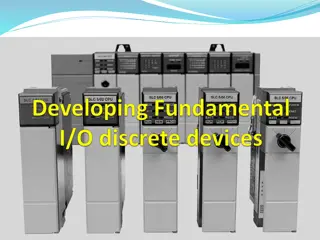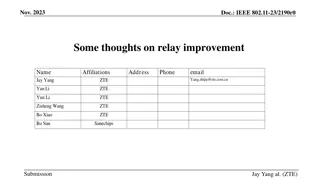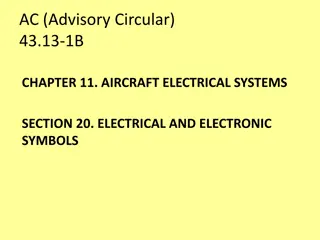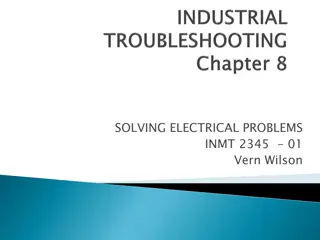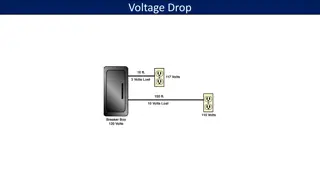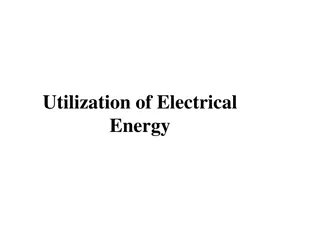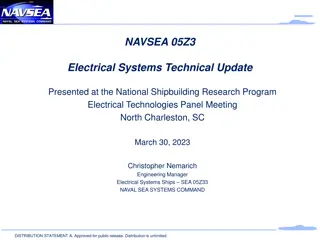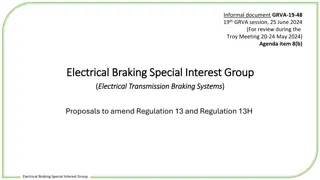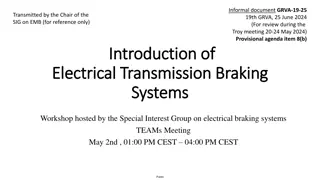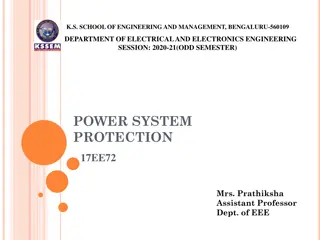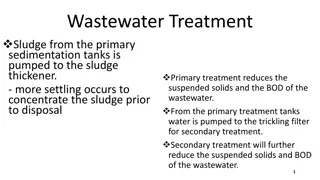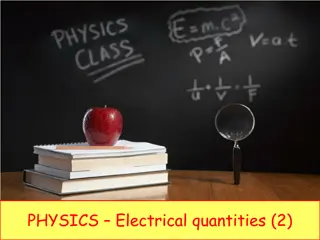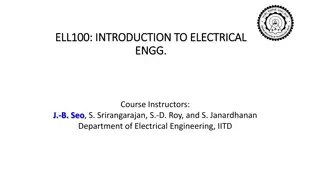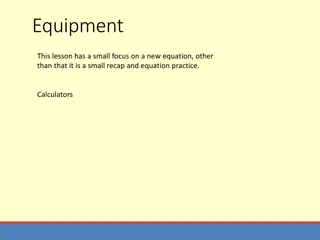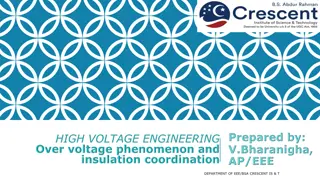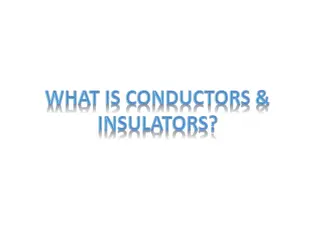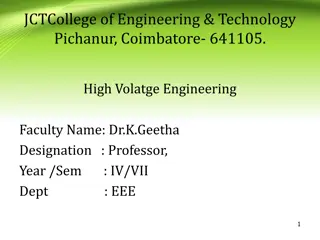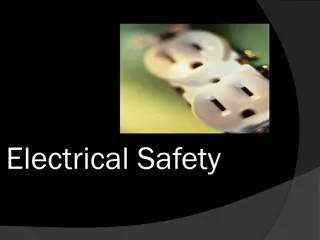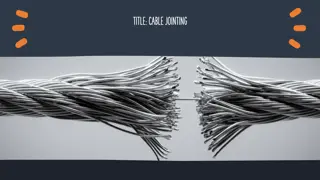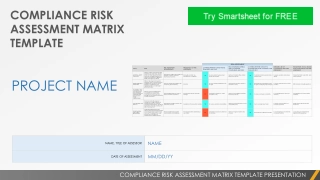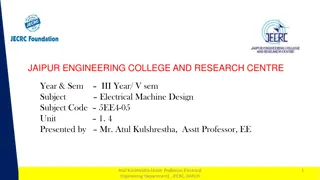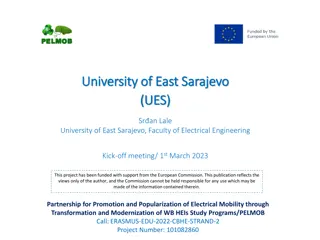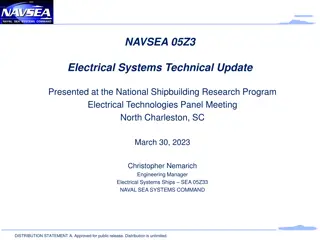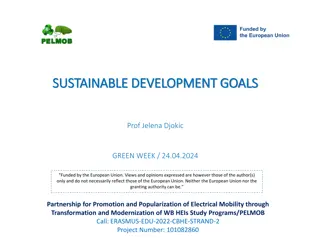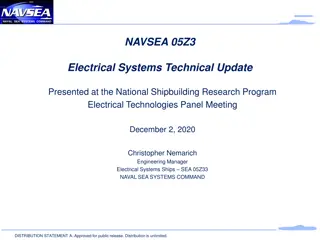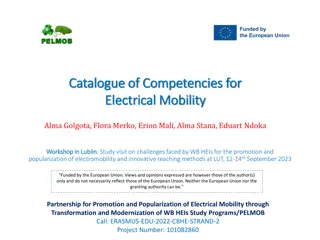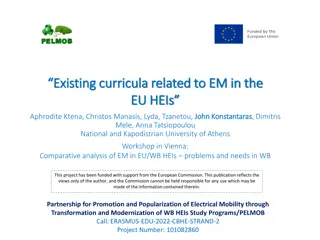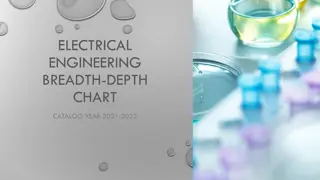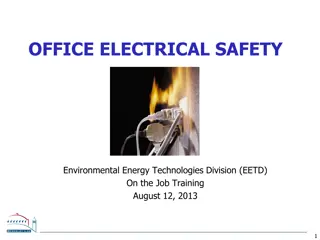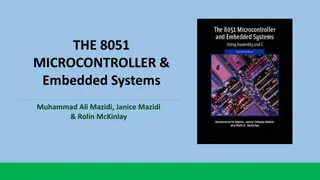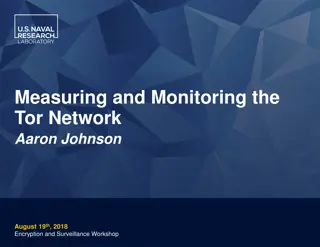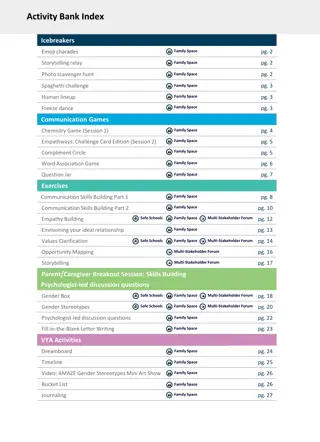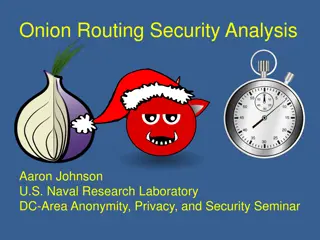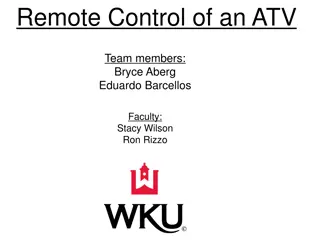Understanding Electrical Relays and Contactors
An electrical relay is a magnetic switch that uses electromagnetism to control contacts. Relays can have various contacts and functions, with coils insulated from contacts. They include normally open (NO) and normally closed (NC) contacts for different operations. Contactors are specialized relays for handling heavy power loads without damage, such as lights, heaters, and motors. Learn about relay operation, coil ratings, and different types of contacts in this comprehensive guide.
Download Presentation

Please find below an Image/Link to download the presentation.
The content on the website is provided AS IS for your information and personal use only. It may not be sold, licensed, or shared on other websites without obtaining consent from the author. Download presentation by click this link. If you encounter any issues during the download, it is possible that the publisher has removed the file from their server.
E N D
Presentation Transcript
An electrical relay is a magnetic switch. It uses electromagnetism to switch contacts. A relay will usually have only one coil but may have any number of different contacts Output circuit Load Contact Relay Coil Switch Input circuit Electromechanical control relay
The coil and contacts are insulated from each other; therefore, under normal conditions, no electric circuit will exist between them The letter M frequently indicates a motor starter, while CR is used for control relays Normally open (NO) contacts are defined as those contacts that are open when no current flows through the coil but that close as soon as the coil conducts a current or is energized Normally closed (NC) contacts are closed when the coil is de- energized and open when the coil is energized Control relay coils and contacts have separate ratings. Coils are rated for the type of operating current (DC or AC) and normal operating voltage
Fix ed contacts Movable contact Armature Spring Coil de-energized Coil energized Relay operation
Normally closed (NC) contacts Normally open (NO) contacts NC NO Stationar y contact Energiz ed Coil Armature Armature Coil Movable contacts Coil de-energized Coil energized CR M M CR Coil Associated contacts Coil Associated contacts Relay normally open and normally closed contacts
A contactor is a special type of relay designed to handle heavy power loads that are beyond the capability of simple control relays Unlike relays, contactors are designed to make and break higher powered circuits without being damaged Such loads include lights, heaters, transformers, capacitors, and electric motors for which overload protection is provided separately or not required
Line side Line side Load side Stationary contact Load side Movable contacts Coil Movable iron armature or plugner Line side Contacts Coil Load side Wiring symbol Three-pole magnetic contactor
Pump Contactor power contact L2 High-current wiring L1 Coil terminals Low-current wiring L2 L1 PLC output module Contactor used in conjunction with a PLC output
A motor starter is designed to provide power to motors The motor starter is made up of a contactor with an overload relay attached physically and electrically Contactor Overload relay Motor starter is a contactor with an attached overload relay
The function of the overload relay can be summarized as follows: Overload relays are designed to meet the special protective needs of motor control circuits They allow harmless temporary overloads that occur when a motor starts The overload relay will trip and disconnect power to the motor if an overload condition persists Overload relays can be reset after the overload condition has been corrected
Start Stop OL M Magnetic starter M Low-current control circuit M OL L1 T1 M OL Three- phase motor T2 L2 M OL T3 L3 High-current power circuit Three-phase magnetic motor starter
Motor Magnetic starter PLC Pushbuttons L1 L2 Outputs Inputs Start Starter coil PLC Program Start Stop OL M Stop M M OL PLC control of a motor
Manually operated switches are controlled by hand such as toggle switches, pushbutton switches, knife switches, and selector switches. Pushbutton switches are the most common form of manual control and can be divided as: Normally open (NO) pushbutton , which makes a circuit when it is pressed Normally closed (NC) pushbutton, which opens the circuit when it is pressed Break-before-make pushbutton in which the top section contacts are NC and the bottom section contacts are NO. When the button is pressed, the top contacts open before the bottom contacts are closed
IEC symbol NEMA symbol IEC symbol NEMA symbol NEMA symbol Break-make Normally open Normally closed Commonly used types of pushbutton switches
The selector switch is another common manually operated switch The main difference between a pushbutton and selector switch is the operator mechanism. A selector switch operator is rotated (instead of pushed) to open and close contacts of the attached contact block Symbol Off 2 Hand 1 A uto 3 Contacts Position AB 1 X 2 A 3 X B Three-position selector switch
Dual in-line package (DIP) switches are small switch assemblies designed for mounting on printed circuit board modules The pins or terminals on the bottom of the DIP switch are the same size and spacing as an integrated circuit (IC) chip DIP switches use binary (on/off) settings to set the parameters for a particular module 1 2 3 4 5 6 7 ON OFF DIP switch
A mechanically operated switch is controlled automatically by factors such as pressure, position, or temperature The limit switch is a very common industrial control device. Limit switches are designed to operate only when a predetermined limit is reached, and they are usually actuated by contact with an object such as a cam Cam (on machine) Operating force IEC symbols Operator NEMA symbols Normally open limit switch Normally closed limit switch Enclosure containing contact mechanism Normally open Normally closed Mechanically operated limit switch
The temperature switch, or thermostat is used to sense temperature changes. Although there are many types available, they are all actuated by some specific environmental temperature change NEMA symbols Programmable thermostat NO contact NC contact IEC symbols NO contact NC contact Temperature switch
Pressure switches are used to control the pressure of liquids and gases. Although many different types are available, they are all basically designed to actuate (open or close) their contacts when a specified pressure is reached NEMA symbols for pressure switch symbols NO contact NC contact IEC symbols for pressure switch symbols NO contact Pressure switches can be pneumatically (air) or hydraulically (liquid) operated switches NC contact Pressure switch
Level switches are used to sense liquid levels in vessels and provide automatic control for motors that transfer liquids from sumps or into tanks. They are also used to open or close piping solenoid valves to control fluids Symbols NO contact NC contact Float type level switch
Sensors are used for detecting, and often measuring, the magnitude of something They convert mechanical, magnetic, thermal, optical, and chemical variations into electric voltages and currents Sensors are usually categorized by what they measure, and they play an important role in modern manufacturing process control
Proximity sensors or switches are devices that detect the presence of an object (usually called the target) without physical contact These solid-state electronic devices are completely encapsulated to protect against excessive vibration, liquids, chemicals, and corrosive agents found in the industrial environment Normally open (NO) sensor symbols IEC NEMA Proximity sensor
Proximity sensors are used when: The object being detected is too small, lightweight, or soft to operate a mechanical switch Rapid response and high switching rates are required, as in counting or ejection control applications An object has to be sensed through nonmetallic barriers such as glass, plastic, and paper cartons Unfriendly environments demand improved sealing properties, preventing proper operation of mechanical switches
Proximity sensors are used when: The object being detected is too small, lightweight, or soft to operate a mechanical switch Rapid response and high switching rates are required, as in counting or ejection control applications An object has to be sensed through nonmetallic barriers such as glass, plastic, and paper cartons Unfriendly environments demand improved sealing properties, preventing proper operation of mechanical switches Long life and reliable service are required A fast electronic control system requires a bounce free input signal
Inductive proximity sensors are used to detect both ferrous metals (containing iron) and nonferrous metals (such as copper, aluminum, and brass) Inductive proximity sensors operate under the electrical principle of inductance, where a fluctuating current induces an electromotive force (emf) in a target object Target Output L1 L2 Metal object OFF Coil Oscillator Detector Output Target Output ON Inductive proximity sensor
The operation of inductive proximity sensor can be summarized as follows: The oscillator circuit generates a high-frequency electromagnetic field that radiates from the end of the sensor When a metal object enters the field, eddy currents are induced in the surface of the object The eddy currents on the object absorb some of the radiated energy from the sensor, resulting in a loss of energy and change of strength of the oscillator The sensor s detection circuit monitors the oscillator s strength and triggers a solid-state output at a specific level Once the metal object leaves the sensing area, the oscillator returns to its initial value.
L1 ( ) Load L2 Load ( ) NO NO L1 Signal Load Load L2 Typical three-wire DC sensor connection Typical two-wire DC sensor connection
Hysteresis is the distance between the operating point when the target approaches the proximity sensor face and the release point when the target is moving away from the sensor face Cube sensor with status LED Hysteresis zone Target Release point Operating point Most proximity sensors come equipped with an LED status indicator to verify the output switching action Proximity sensor sensing range
Capacitive proximity sensors are similar to inductive proximity sensors. The main differences between the two types are that capacitive proximity sensors produce an electrostatic field instead of an electromagnetic field and are actuated by both conductive and nonconductive materials Sensor electrodes Electrostatic field Oscillator waveform T arget absent T arget absent T arget present Metallic or Nonmetalic target Capacitive proximity sensor
Capacitive proximity sensors will sense metal objects as well as nonmetallic materials such as paper, glass, liquids, and cloth They typically have a short sensing range of about 1 inch regardless of type of material being sensed The larger the dielectric constant of a target, the easier it is for the capacitive sensor to detect. This makes possible the detection of materials inside nonmetallic containers Capacitive proximity sensor liquid detection
A magnetic reed switch is composed of two flat contact tabs that are hermetically sealed (airtight) in a glass tube filled with protective gas When a magnetic force is generated parallel to the reed switch, the reeds become flux carriers in the magnetic circuit. The overlapping ends of the reeds become opposite magnetic poles, which attract each other N S Magnetic reed switch
A photoelectric sensor is an optical control device that operates by detecting a visible or invisible beam of light and responding to a change in the received light intensity Photoelectric sensors are composed of two basic components: a transmitter (light source) and a receiver (sensor) Receiver Load Modulated light beam Object to be sensed Photoelectric sensor Transmitter
The scan technique refers to the method used by photoelectric sensors to detect an object The through-beam scan technique (also called direct scan) places the transmitter and receiver in direct line with each other Receiver Transmitter Through-beam scan
In a retroreflective scan, the transmitter and receiver are housed in the same enclosure This arrangement requires the use of a separate reflector or reflective tape mounted across from the sensor to return light back to the receiver Transmitter Reflector Receiver Retroreflective scan
Fiber optic sensors use a flexible cable containing tiny fibers that channel light from emitter to receiver Through-beam To receiver From transmitter From transmitter Fiber optic sensor systems are completely immune to all forms of electrical interference Retroreflective To receiver Fiber optic sensors
Bar code technology is widely implemented in industry to enter data quickly and accurately A light source within the scanner illuminates the bar code symbol; those bars absorb light, and spaces reflect light A photodetector collects this light in the form of an electronic- signal pattern representing the printed symbol. Diverter Scanner/decoder Programmable controller PLC bar code application
An ultrasonic sensor operates by sending high- frequency sound waves toward the target and measuring the time it takes for the pulses to bounce back Detecting the level of chocolate Detecting transparent bottles 4- to 20-mA output The time taken for this echo to return to the sensor is directly proportional to the distance or height of the object because sound has a constant velocity Inches 30 Inches 5 10 15 20 25 30 5 4 20 Output (mA) Level detection Ultrasonic sensor
A strain gauge converts a mechanical strain into an electric signal Hopper Programmable controller Strain gauges are based on the principle that the resistance of a conductor varies with length and crosssectional area ON/OFF control 56 kg PLC sensor input Drum The force applied to the gauge causes the gauge to bend which in turn changes its resistance Load cell Strain gauge load cell
The thermocouple is the most widely used temperature sensor Thermocouples operate on the principle that when two dissimilar metals are joined, a predictable DC voltage will be generated that relates to the difference in temperature between the hot junction and the cold junction The hot junction (measuring junction) is the joined end of a thermocouple that is exposed to the process where the temperature measurement is desired The cold junction (reference junction) is the end of a thermocouple that is kept at a constant temperature to provide a reference point Because of their ruggedness and wide temperature range, thermocouples are used in industry to monitor and control oven and furnace temperatures
Metal A Chromel(nickel-chromium) HEAT Leads 300 C 12.2 mV Hot Metal B junction Alumel (nickel-aluminum) type K thermocouple Thermocouple temperature sensor
Turbine-type flowmeters are a popular means of measurement and control of liquid products in industrial, chemical, and petroleum operations Turbine flowmeters uses their angular velocity (rotation speed) to indicate the flow velocity The bladed rotor rotates on its axis in proportion to the rate of the liquid flow through the tube A magnetic pickup sensor is positioned as close to the rotor Fluid passing through the flow tube causes the rotor to rotate, which generates pulses in the pickup coil The frequency of the pulses is then transmitted to readout electronics
Readout electronics Gallons/minute Generated pulses Magnetic pickup Flow Rotating turbine Turbine type flowmeter
Tachometer generators are converting rotational speed into an analog voltage signal that can be used for motor speed indication and control applications 1450 r pm Load CONTR OLLER Separ ate tachometer gener ator Motor Tacho A tachometer generator is a small AC or DC generator that develops an output voltage (proportional to its rpm) whose phase or polarity depends on the rotor s direction of rotation Tachometer generator feedback
An encoder is used to convert linear or rotary motion into a binary digital signal Optical sensor Light source The optical encoder uses a light source shining on an optical disk with lines or slots that interrupt the beam of light to an optical sensor Optical encoder Optical disc An electronic circuit counts the interruptions of the beam and generates the encoder s digital output pulses Lines Optical encoder
A variety of output control devices can be operated by the PLC output to control traditional industrial processes Alarm ALARM PL Pilot light HTR Heater CR1 SOL Solenoid Relay CR1-1 CR1-2 NO NC Solenoid valve SV M Motor starter coil MTR Motor OL Motor over load relay contact Horn Symbols for output control devices
An actuator, in the electrical sense, is any device that converts an electrical signal into mechanical movement An electromechanical solenoid is an actuator that uses electrical energy to magnetically cause mechanical control action. A solenoid consists of a coil, frame, and plunger Frame DC solenoid Air Symbol Coil Plunger AC solenoid Solenoid construction and operation
Solenoid valves are electromechanical devices that work by passing an electrical current through a solenoid, thereby changing the state of the valve Normally, there is a mechanical element, which is often a spring, that holds the valve in its default position A solenoid valve is a combination of a solenoid coil operator and valve, which controls the flow of liquids, gases, steam, and other media When electrically energized, they open, shut off, or direct the flow of media
Coil de-energized L1 Control circuit L2 Solenoid coil de-energized Inlet Outlet Solenoid control Valve opened Coil energized V alv e L1 Control circuit L2 Inlet Solenoid valve construction and operation Solenoid coil energized Valve closed
Stepper motors operate differently than standard types of motor The shaft of a stepper motor rotates in discrete increments (steps) when electrical command pulses are applied to it in the proper sequence Every revolution is divided into a number of steps, and the amount of rotation is directly proportional to the number of pulses A 1-degree-per-step motor will require 360 pulses to move through one revolution; the degrees per step are known as the resolution Stepper systems are used most often in open-loop control systems, where the controller tells the motor only how many steps to move and how fast to move
Stepper motor Rotary application Motor drive Linear application Stepper motor/drive unit


